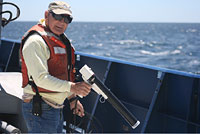

 | |||||||||||||||
|
|
Journals 2008/2009Jeff Lawrence
December 11, 2008 Bud Hale who is the technology technician aboard the REVELLE releases the EBT (Expendable Bathy Thermograph) off the port side of the ship while we were underway. The EBT uses a thermistor that is attached by a very small copper wire that measures the temperature 1,000 meters down. The water surface temperature is getting progressively colder as we head further south. Two days ago it was around 18°C and is now at 13°C. When it reaches the proper depth, which is determined by using a watch and timing it to three minutes, the wire is then detached. The wire attached to the tube that sends data to the ship is so thin it is broken with a slight pull by the hand. The plastic in the device is made so that it dissipates very rapidly in the ocean and the salt water breaks down the metal wire very quickly. Scientist do not want to throw things that are harmful into the ocean, this is of prime importance for any of us but especially aboard a research vessel. Every effort is made to make sure nothing harmful is left in the oceans that we are trying to protect. This device (EBT) helps to calibrate the bathymetry on the REVELLE, which is constantly turned on while the ship is sailing, giving a profile of the ocean floor and of what may lie on the ocean floor beneath the ship. Anything related to technology on the ship and Bud has a hand in it. He helps maintain the computers, ship to shore transmissions, data retrieval and dispersal of scientific data, and many other tech related duties. Bud plays a vital role aboard the ship. Daniel Yang is also aboard and he is very helpful with computer related issues for all that are on board. He helps with the technology and electronics on the ship. Daniel has assisted me to Skype my students back at Lowrey School in Oklahoma, we were able to chat live, although a little choppy. But that is to be expected when you are on the bottom of the globe in the middle of an ocean. The audio worked a better, but the live chat session was seamless. This gives my students the ability to pose questions to me and other scientist aboard the REVELLE.
Below is a picture of the British delegation that is aboard the REVELLE. They are getting an instrument ready that will be sent down 1,000 meters. The instrument is called a SAP (Stand Alone Pump). It is basically a water pump with two big filters in it. Although the filters are fairly large due to the amount of water pumped through them, the size of particulates it traps is very small. One filter is for biologics of 100 microns and the other filter is for life forms of 10 microns, so it samples very small life forms that live in the ocean at a particular depth. Scientist will use the SAP to filter water at a 1,000 m to see what may lie within the water column at that depth. This allows scientists to go very deep to collect samples in their natural environment without first bringing the water to the surface and then filtering it, which is what occurs with the CTD. John Allen heads the British team who are here as part of a multinational group of scientist intent on studying the south Atlantic Patagonian Shelf ocean basin.
Questions of the day:
|
||||||||||||||


